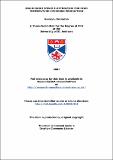Files in this item
Solid oxide steam electrolysis for high temperature hydrogen production
Item metadata
| dc.contributor.advisor | Irvine, John T. S. | |
| dc.contributor.author | Eccleston, Kelcey L. | |
| dc.coverage.spatial | vii, 168 p. | en |
| dc.date.accessioned | 2007-04-30T15:08:06Z | |
| dc.date.available | 2007-04-30T15:08:06Z | |
| dc.date.issued | 2007-06-20 | |
| dc.identifier | uk.bl.ethos.551997 | |
| dc.identifier.uri | https://hdl.handle.net/10023/322 | |
| dc.description.abstract | This study has focused on solid oxide electrolyser cells for high temperature steam electrolysis. Solid oxide electrolysis is the reverse operation of solid oxide fuel cells (SOFC), so many of the same component materials may be used. However, other electrode materials are of interest to improve performance and efficiency. In this work anode materials were investigated for use in solid oxide electrolysers. Perovskite materials of the form L₁₋xSrxMO₃ , where M is Mn, Co, or Fe. LSM is a well understood electrode material for the SOFC. Under electrolysis operation LSM performed well and no interface reactions were observed between the anode and YSZ electrolyte. LSM has a relatively low conductivity and the electrode reaction is limited to the triple phase boundary regions. Mixed ionic-electronic conductors of LSCo and LSF were investigated, with these materials the anode reaction is not limited to triple phase boundaries. The LSCo anode had adherence problems in the electrolysis cells due to the thermal expansion coefficient mismatch with the YSZ electrolyte. The LSCo reacted with the YSZ at the anode/electrolyte interface forming insulating zirconate phases. Due to these issues the LSCo anode cells performed the poorest of the three. The performance of electrolysis cells with LSF anode exceeded both LSM and LSCo, particularly under steam operation, although an interface reaction between the LSF anode and YSZ electrolyte was observed. In addition to the anode material studies this work included the development of solid oxide electrolyser tubes from tape cast precursor materials. Tape casting is a cheap processing method, which allows for co-firing of all ceramic components. The design development resulted in a solid design, which can be fabricated reliably, and balances strength with performance. The design used LSM anode, YSZ electrolyte, and Ni-YSZ cathode materials but could easily be adapted for the use of other component materials. Proper sintering rates, cathode tape formulation, tube length, tape thickness, and electrolyte thickness were factors explored in this work to improve the electrolyser tubes. | en |
| dc.format.extent | 12799293 bytes | |
| dc.format.mimetype | application/pdf | |
| dc.language.iso | en | en |
| dc.publisher | University of St Andrews | |
| dc.rights | Creative Commons Attribution-NonCommercial-NoDerivs 3.0 Unported | |
| dc.rights.uri | http://creativecommons.org/licenses/by-nc-nd/3.0/ | |
| dc.subject | Fuel cells | en |
| dc.subject | Electrolysis | en |
| dc.subject | Hydrogen | en |
| dc.subject | Solid oxide | en |
| dc.subject.lcc | QD568.E3 | en |
| dc.subject.lcsh | Electrolytic cells | en |
| dc.subject.lcsh | Anodes--Materials | en |
| dc.subject.lcsh | Perovskite | en |
| dc.subject.lcsh | Steam | en |
| dc.subject.lcsh | Hydrogen | en |
| dc.subject.lcsh | Water--Electrolysis | en |
| dc.subject.lcsh | Solid oxide fuel cells--Materials | en |
| dc.title | Solid oxide steam electrolysis for high temperature hydrogen production | en |
| dc.type | Thesis | en |
| dc.type.qualificationlevel | Doctoral | en |
| dc.type.qualificationname | PhD Doctor of Philosophy | en |
| dc.publisher.institution | The University of St Andrews | en |
This item appears in the following Collection(s)
Except where otherwise noted within the work, this item's licence for re-use is described as Creative Commons Attribution-NonCommercial-NoDerivs 3.0 Unported
Items in the St Andrews Research Repository are protected by copyright, with all rights reserved, unless otherwise indicated.


